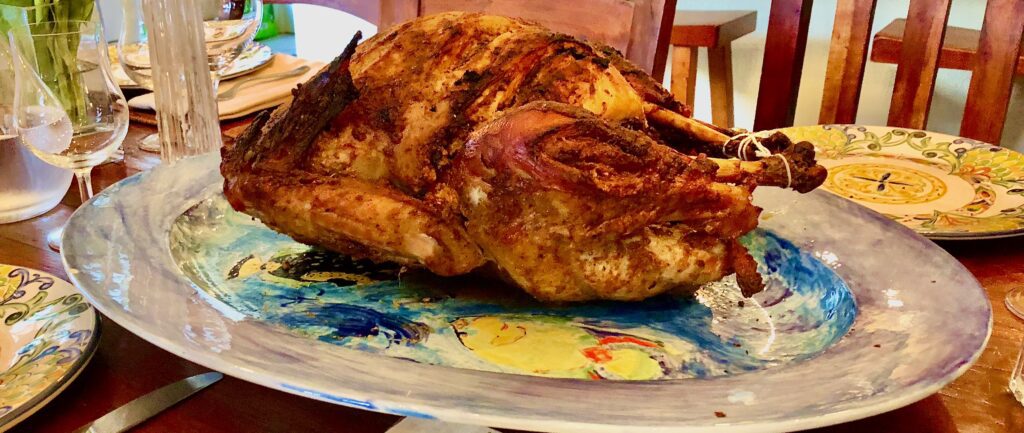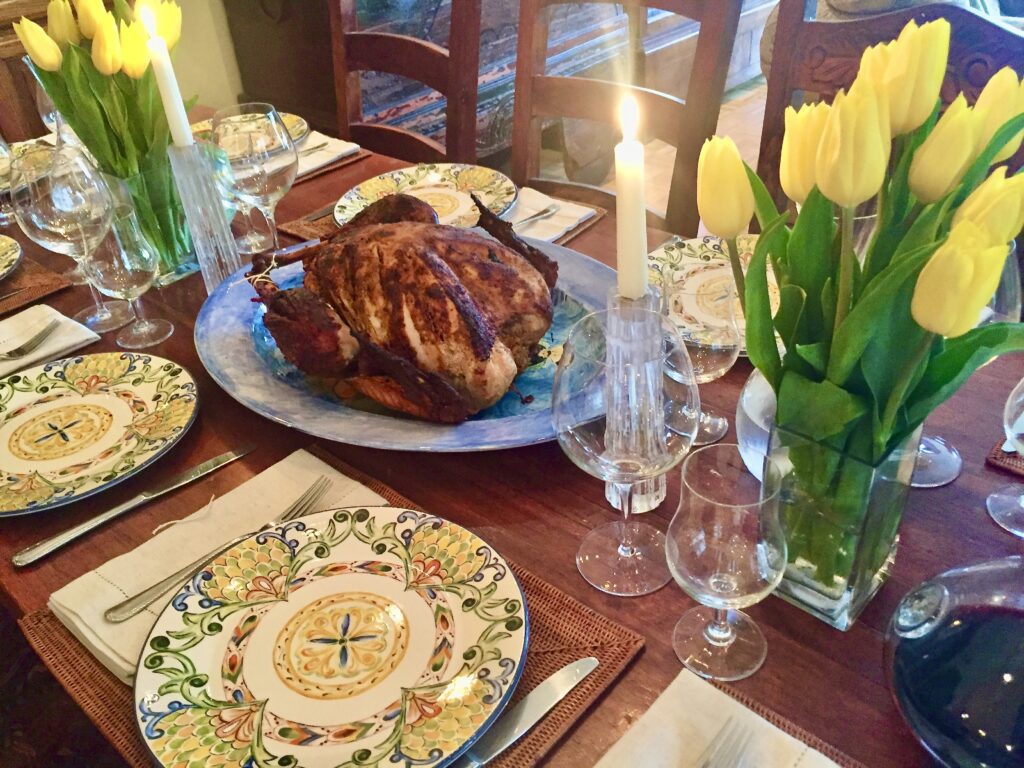
This wildly aromatic Tandoori turkey has been at the heart of our Thanksgiving family tradition for many years. The smell of these exotic spices is always a sure sign in our wild savory kitchen that the Holidays have begun. Originating 5000 years ago in the Indus River Valley, and later the Punjab region of India, traditional Tandoori cooking was done inside huge 5 to 6 foot high clay pots, which were buried in the ground with a charcoal or wood fire blazing inside, at the base of the pot itself. Tandoori pots are explosively fiery and hot, with smoke and flames belching out and the intense glowing heat sometimes reaching 900 degrees. The technique may be ancient, but the actual cooking technique is also very modern. The searing of the meat seals in the flavors and juices.
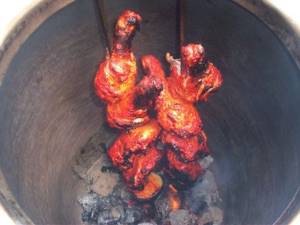
Chicken, lamb or turkey, which have been marinated in spicy yogurt, are dangled into a flaming furnace and the radiant heat and the natural convection action of the swirling air sear and broil the flesh. At the same time, the juices fall into the charcoal and coals, naturally smoking the meats. Using a very hot oven and a long marinating time, and grinding our own authentic and traditional spices, we have found a way to bring this iconic Indian feast into our kitchen.
After the Mughal stormed out of Central Asia on their fearless small horses, invading and conquering India in the 1500s, they were disappointed with the local food, compared to the spicy aromatic feasts from their homeland. So they introduced their own soul food from back home, their creamy yogurt marinates and their unique spices, which blended Turkish, Persian and even Arab tastes. Like our own kitchen, these cooks were quite willing to mash up all the cool spicy stuff they could find to get to a culinary awesomeness. This was India’s original umami bomb. These are the spices that continue to be used to make Tandoori, and these are the Mughal spices we grind and use in our kitchen on Thanksgiving and holidays.
And every year, once the turkey is carved and the dressing served, all eyes are on Rebekah’s family legend gravy, as it is brought to the table, made from the drippings from this aromatic spicy feast.
Ingredients
14-16 pound turkey
6 lemons, juiced
2 tablespoon sea salt, 1 for the turkey dry brine and 1 for the marinade (generally we use 1 teaspoon salt for every 1 1/2 to 2 pounds of meat, so a 14 pound turkey needs about 2 tablespoons)
4 cups plain Greek yogurt
1/4 cup coconut oil
1/4 cup olive oil
5 heaping tablespoons fresh ginger, grated
12 large garlic cloves, crushed
(put grated ginger and crushed garlic in a mortor and pestal, add 1 teaspoon of water and mash into a paste)
Curry Powder
2 tablespoons cayenne pepper
2 tablespoons smoked Spanish paprika
8 teaspoons ground coriander
8 teaspoons dry mustard
4 teaspoons freshly ground white pepper
3 tablespoons fresh garam masala
2 teaspoons freshly ground turmeric
2 teaspoons ground fenugreek
6 star anise, ground
6 green cardamom pods, ground
1 tablespoon cumin seed, ground
Prep Work
Two nights before we will be baking the turkey, we always dry brine the bird. It’s very simple, just sprinkle on the tablespoon of salt under as much of the skin as you can, in all the spaces between the legs and and thighs and breast, including the cavity, and rub the rest of the salt right onto the skin. This will draw out the natural juices in the meat and will make the turkey incredibly juicy and flavorful.
On the night before we will be baking the turkey, we make the yogurt marinade with all the ground spices. For a spicy Tandoori turkey, it’s best to use all fresh ingredients, which you need to grind with a spice grinder. The spiced yogurt must be very pungent, your bare hands should tingle from the mixture.
Place the turkey in a large roasting pan and make three or four gashes on each side of the breasts, at 45 degree angles to the spine. Three gashes for a smaller turkey, four gashes for a larger bird.
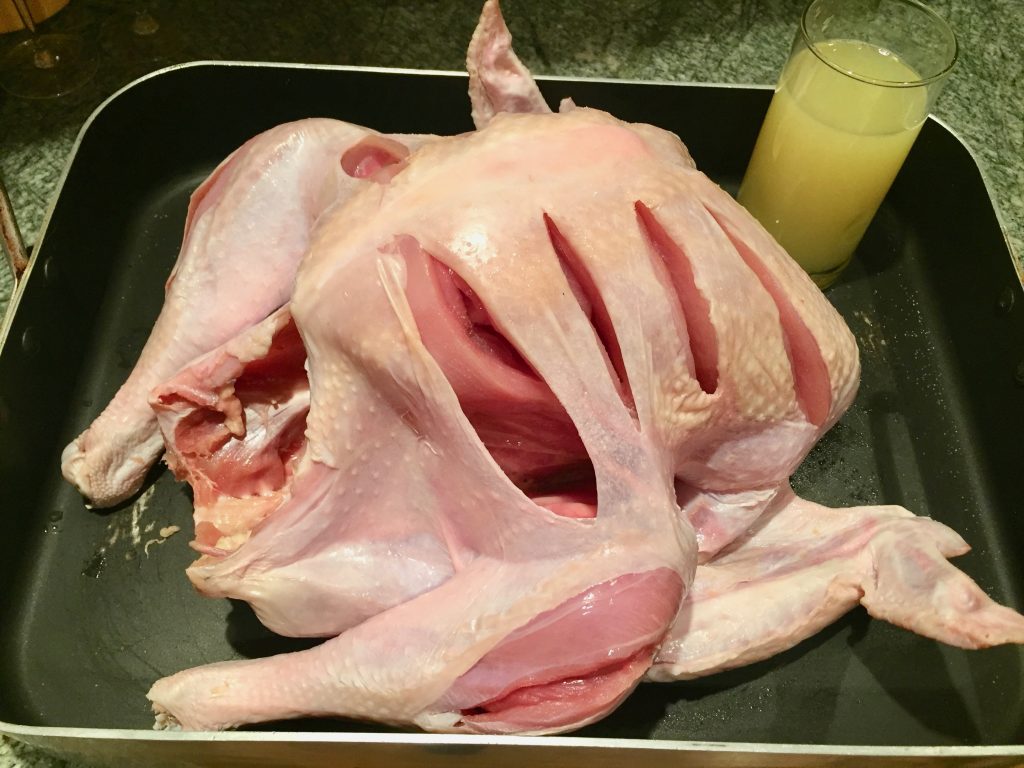
They must be very deep, but NOT all the way through, or the yogurt mixture will simply seep into the body cavity, making the dressing too moist. Also gash the legs and thighs deeply – all the way to the bone.
Place yogurt in large food processor, it’s best to do two batches of marinade, since it’s too much volume for one batch. Add oil, ginger/garlic paste, salt and all the spices. Mix in short bursts until well blended.
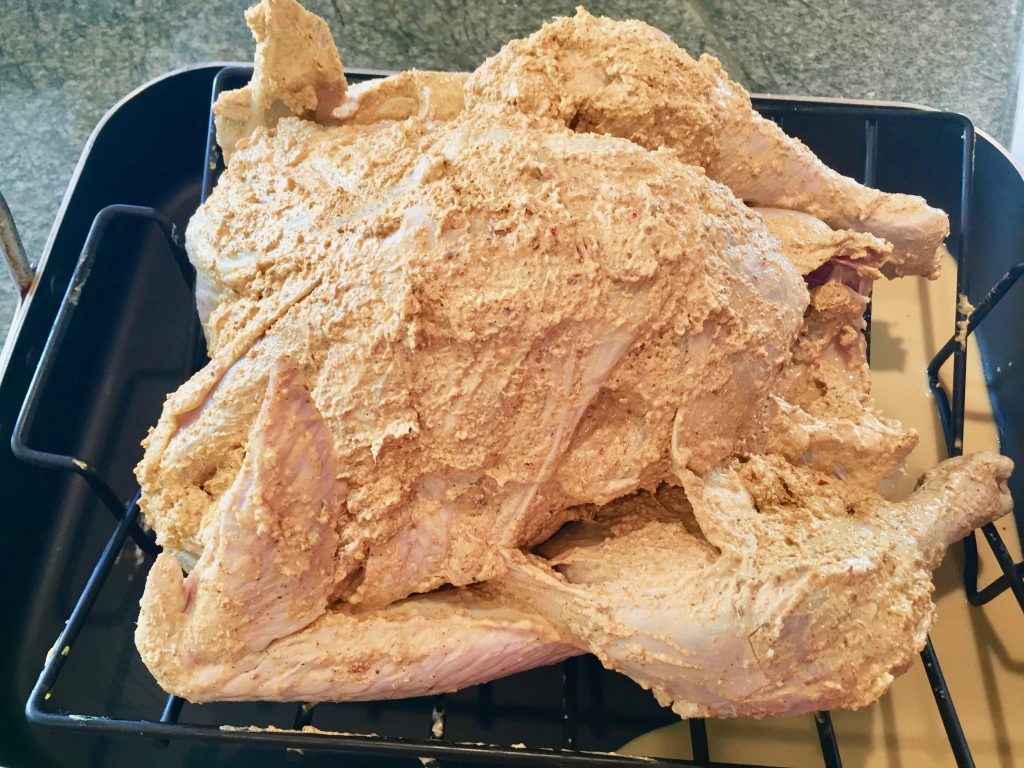
Coat the turkey with the now spicy yogurt, inside and out, especially in the gashes, making sure all parts are heavily covered.
When covering the turkey with the yogurt, lift the skin from the flesh on top and allow the mixture to be on the flesh all over, and then put skin back in place. This process is messy, so get the aprons out.
Pour the mixture into the cavity, and allow it to pool in there, and into the legs and thigh gashes. The overnight marinate is crucial. Put the turkey and all the rest of the marinade in a large oven bag for turkeys, available at most supermarkets.
On baking day, place the turkey in a large roasting pan and pour the marinate that is in the bag back into all the gashes.
Preheat the oven to 475 and prepare the stuffing for the bird.
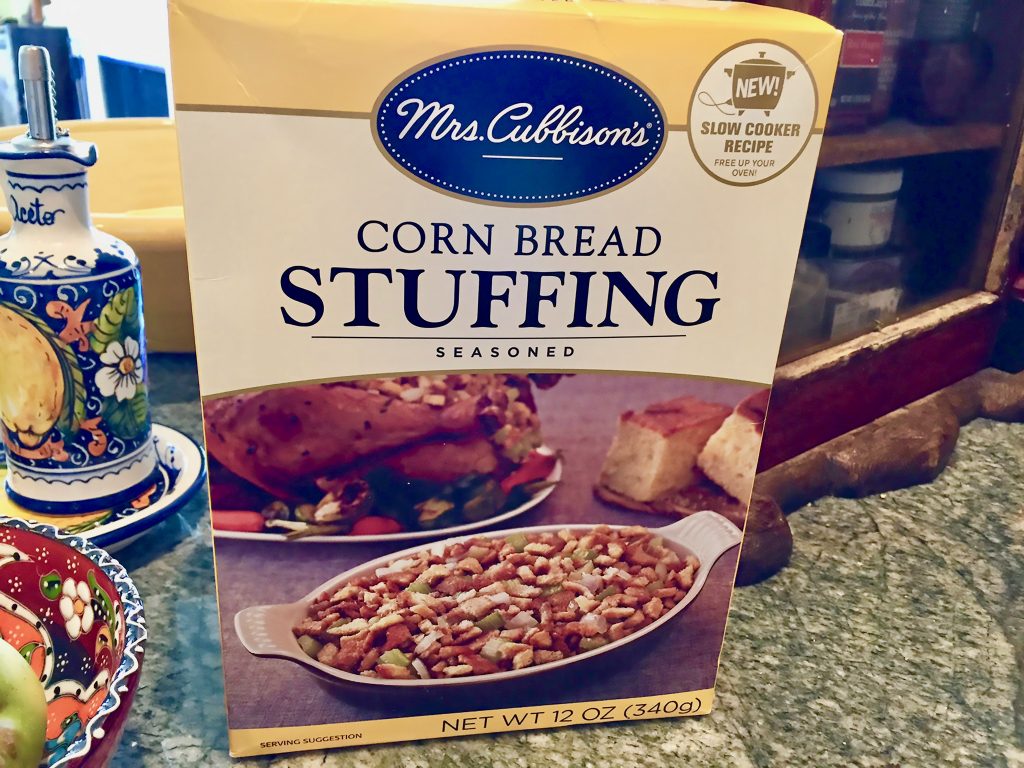
Tandoori Turkey Stuffing
1 bag corn bread stuffing (we use Cubbison’s, for the old timey vibe)
1 to 2 bags seasoned stuffing (Cubbison’s)
6 inner celery stalks chopped, with leaves
1 large sweet yellow onion, chopped
2 sticks butter (8 ounces)
16 oz chicken broth (we boil down the bones of a whole roasted chicken) or sometimes we use duck broth
3 cinnamon sticks, broken into 1 inch pieces
1 heaping teaspoon ground cinnamon, (to sprinkle on top)
1/2 cup orange flavored dried cranberries
1 large Granny Smith apple, (or two small), chopped to the size of a thumb nail
2 tablespoons of fresh sage (we use Cleveland sage in our garden, which is native to the hills of California)
1 teaspoon nutmeg
10 cloves, ground
(Note: you will need 2 fry pans, each at least 12 inches wide)
Cooking
Mix together the dry corn bread and the seasoned stuffing in a big bowl. Melt 1/2 stick of butter in each fry pan and gently sauté the onions and celery until blanched. Add dry stuffing, equally, to the pans, coating the stuffing with butter.
Slowly add the chicken broth to both pans until SLIGHTLY moist. Add the cinnamon, cranberries, chopped apple, sage and nutmeg, in that order. Using a wooden spoon, mix thoroughly.
Place a portion of the stuffing in a large bowl – this will be for the turkey cavity. Put the remaining stuffing in a pyrex roasting pan, cover with foil and bake at 400 degrees at least an hour before sitting down to eat.
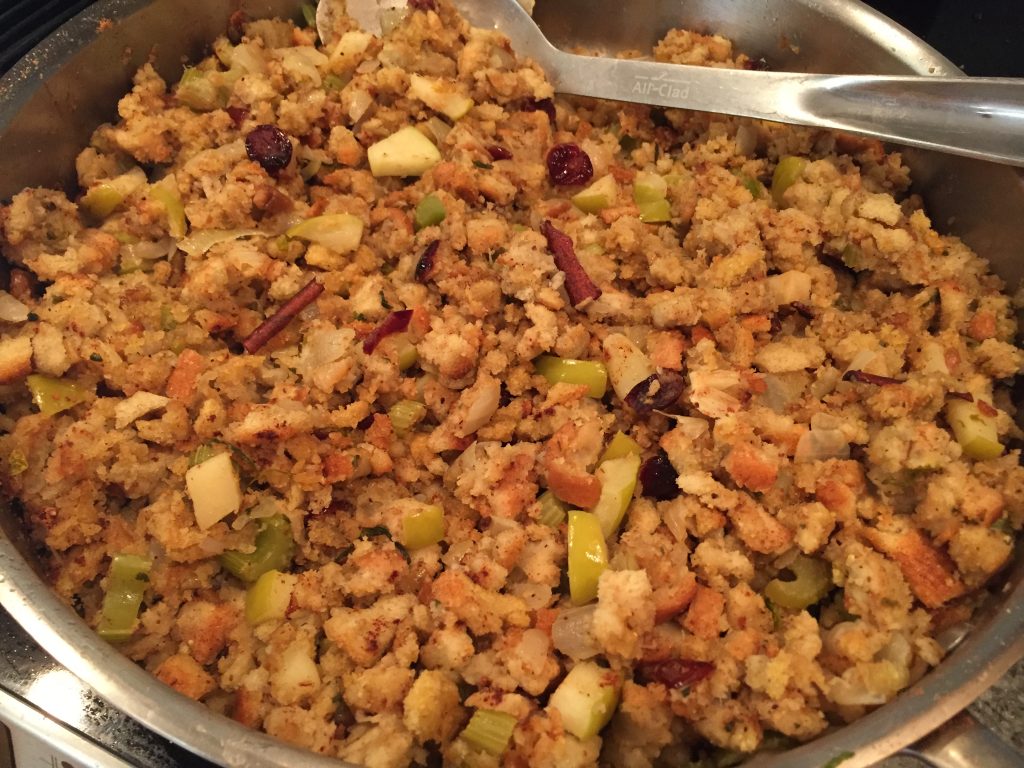
Roasting the Turkey
If you choose not to stuff the turkey with dressing, place the dressing in a separate shallow pan, cover with foil, and bake later. Place the bird in a roasting pan with a wire grate that holds the turkey up off the bottom of the pan for circulation of heat. There is so much liquid in all this that you can’t really dry out the bird. The turkey will look a bit burned at the end, and that’s what you want… Tandoori flavors are all about searing the spices and the yogurt deep into the flesh of the bird.
Roast the turkey at 475 degrees for an hour, then cover loosely with foil and roast at 325 for 4 hours if stuffed… if not stuffed, for 3 hours. Every hour, remove foil and brush/baste the bird with melted butter and the drippings from the bottom of the roasting pan.
At the total 3 hour mark, check the turkey’s progress using a meat thermometer, inserting into the deepest part of the thigh. The internal temperature should register at least 140 degrees. For the last hour remove foil, baste with drippings several more times and roast until the meat thermometer reaches 165 degrees and the turkey is beautifully toasty.
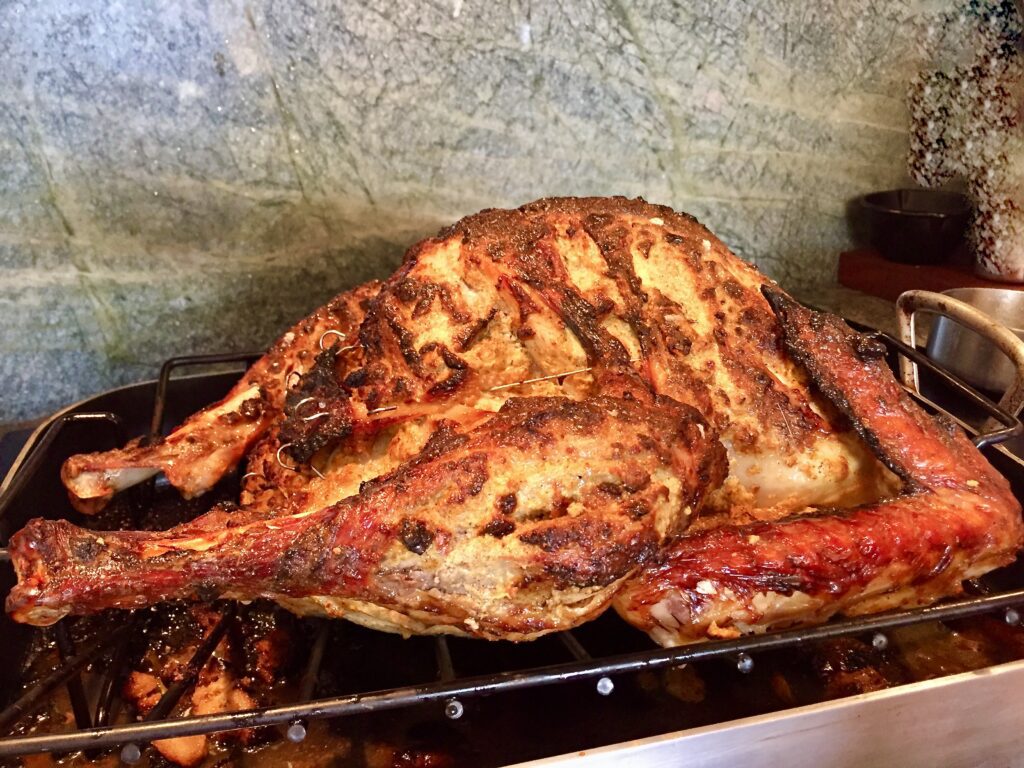
Making the gravy
Place the turkey roasting pan across front and back stove burners, keeping the heat between low to medium-low. Add 2 sticks of butter and 1-2 cups of chicken broth to the turkey’s filtered roasting juices.
After the butter has dissolved, add a little ground red chile or cayenne to taste. Using a whisk, SLOWLY add pinches of flour and stir continuously until the gravy is a nice even consistency, no clumps and not too thick.
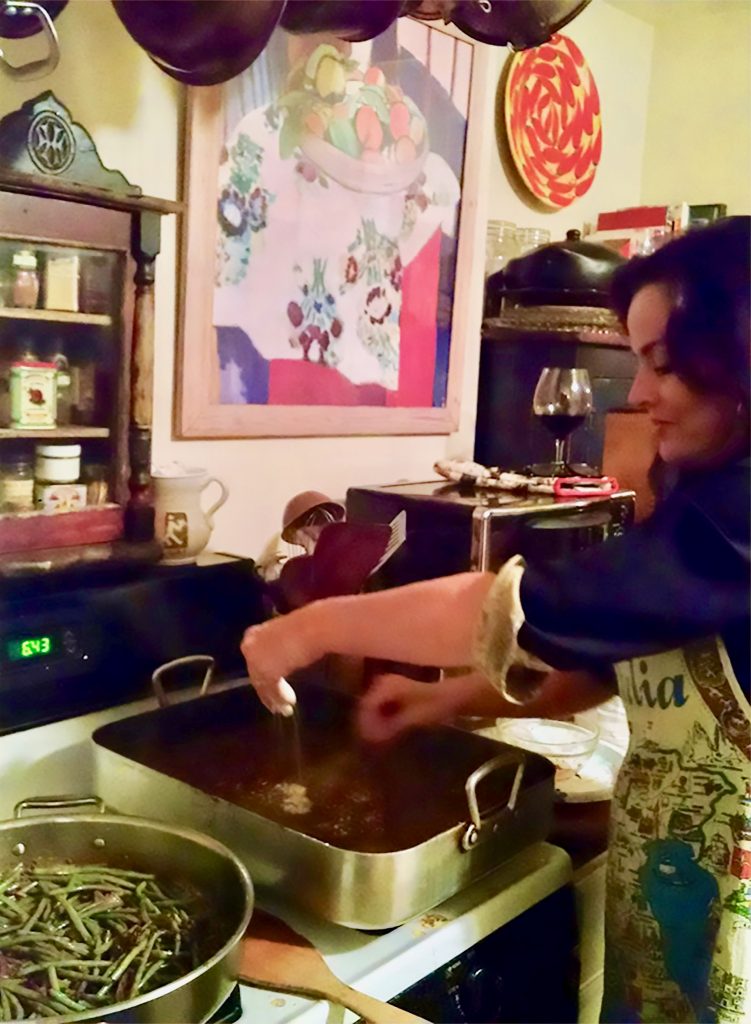
The key is to keep the temperature in the pan at a “just before boiling” temperature. The consistent heat and large surface area of the pan helps dissolve the flour as it is added so it doesn’t clump. Salt and pepper to taste.
This fabulous meal is another reason to be thankful, because it brings family and friends together in the kitchen on a day of Thanksgiving, where everyone is welcome at the Harvest Table. Enjoy!
